Concurrent with the summer solstice, the European Music Festival returns on 21 June. Free concerts will be held nationwide to reaffirm the universal nature of an inclusive art form capable of uniting and bringing people together like no other language.
The European Music Festival in Italy reaches its 29th edition
As in previous years, a full calendar of events for the 29th edition, with a multitude of concerts in all Italian regions. Taking advantage of its local characteristics, each city will delight us by enhancing its beauty. Suggestive performances by the sea, enveloped in the magical atmosphere of the night or bathed by the stars. Here, the common thread is to celebrate music in all its expressions, a source of energy and emotions that nourishes the heart, mind and spirit.
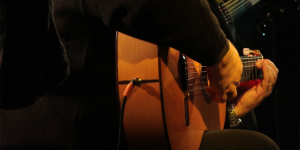
This year, the recurring motif deal with environmental issues. The title “VIVI LA VITA” (meaning “LIVE YOUR LIFE” is not only an ode to freedom but also a need to raise awareness of the entire country and reaffirm the social, aggregative and elevating role of music. To learn about all the events planned in the city you are in or anywhere else, please visit the European Music Festival 2023 offcial website. (available only in Italian)
Origins of the event
To find the true roots of the initiative, we have to go back to France 41 years ago. In 1982, Maurice Fleuret, music critic and newly elected Director of the Music and Dance Department of the Ministry of Culture, established a free festival open to all music genres in collaboration with Jack Mathieu Emile Lang, Minister of Culture.
Under the famous slogan ‘”Music everywhere, concerts nowhere“, all French citizens flooded the streets with the sound of all instruments, playing their favourite genre. Professional musicians, enthusiasts, and amateurs answered this unique call
“Show what you can do! Play music in the streets, kiosks, stations, all public places…”

Alleys, streets, squares, schools, museums, airports, stations, libraries and religious buildings still share a moment of gathering and participation in a heritage accessible to all with an aggregative and cosmic nature. It is no coincidence that the date of 21 June, the summer solstice, has had a strong symbolism since the earliest cultures.
The birth of the Music Festival in Italy
A few years later, in 1985, the festival achieved a broader scope, going beyond the French borders. Rome and Naples led this phenomenon which many other Italian cities later joined. Far and wide, the whole nation celebrates this event to the sound of music in the name of sharing, equality, socialisation, integration and cohesion.
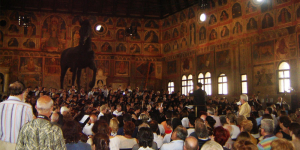
The longest day of the year becomes a time to promote a treasure common to humanity, without any distinction, extending to places of distress and suffering such as prisons and hospitals. All around is melody, thanks to the participation of music schools, professionals, conservatories, amateurs, associations, orchestras, bands and choirs performing representing all genres.
Curiosities about Music
The term music, deriving from the Greek noun μουσική (mousikè) and the Latin musĭca, is closely related to the Muses, Greek and Roman mythological figures and protectors of the Arts.
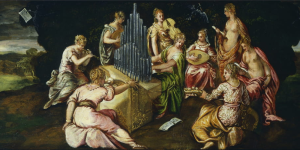
Since we do not want to plunge into the history of music itself, nor mention the immense Italian artistic heritage of composers, musicians and master craftsmen capable of forging precious instruments, we will provide a few nice and singular tidbits.
The mysterious evocative power of Music
Music can bring back emotions, feelings, sensations and even people buried in our memory. The phenomenon, known as “autobiographical memory evoked by music“, is an involuntary event that occurs in the form of memories tuning us into the past, creating a seemingly inexplicable connection.
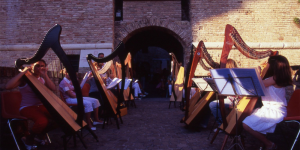
This artistic expression, the soundtrack of our lives, acts on us with emotional sounds. It can vibrate the chords of the heart and the folds of the soul as not even the words of the most skilful poet could. It is no coincidence that we refer to the universality of music, which can unite all peoples thanks to the evocative power of sounds.
The benefits of Music
According to some research, listening to music or singing for at least an hour a day helps to reduce stress, improve sleep quality and, in general, boosts the immune system.
In particular, our brain produces dopamine, an important neurotransmitter, and endorphins, which are responsible for the feeling of well-being. Have you ever wondered why children fall asleep to music?

In addition, loud music in pubs or discos is said to increase drink consumption. It reduces the time necessary to empty the glasses. True or not, clubs never keep the music low. Try it to believe it!
On the other hand, shops, especially clothing shops, adopted the strategy of soft sounds to allow customers to relax and feel at ease to be more willing to buy.
Italian records
Did you know that it was an Italian who invented today’s musical notes?
The monk Guido d’Arezzo carried out a real revolution that would export music outside the abbeys, making it accessible to all.
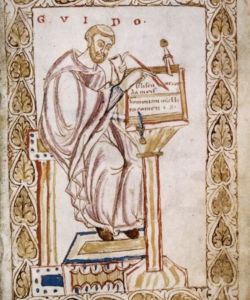
We are around the year 1000, during the Middle Ages, when the friar, inspired by the first syllables of the Hymn to St John the Baptist by Paolo Diacono, named the notes
«Ut queant laxis ‖ Resonare fibris
Mira gestorum ‖ Famuli tuorum,
Solve polluti ‖ Labii reatum,
Sancte Iohannes.»
For the introduction of the “do” (which replaced the “ut”), we need to wait until the 17th century and Giovanni Battista Doni, who “borrowed” the first two letters of his surname.
Did you know that an Italian artist made the most expensive instrument in the world?
We are talking about the Stradivari Macdonald Viola valued at $45 million. Built by Antonio Stradivari in 1719, there are only 2 pieces worldwide. The famous Cremonese luthier forged a wide variety of instruments.
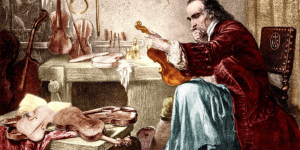
There are over 1100 violas and violins and as many as 80 cellos played by the most excellent musicians of all time, including, for example, Niccolò Paganini.
Do you know which are the most famous Italian songs abroad?
Alongside the great classics such as Domenico Modugno‘s Nel blu dipinto di blu, Andrea Bocelli‘s Con te partirò, Renato Carosone’s Tu vuo’ fa’ l’americano, the Spanish version of Raffaella Carrà’s famous Tanti Auguri (Hay que venir al sur), we find the up-and-coming Måneskin, and Eiffel 65, already known in Italy for their danceable catchphrases in the 1990s. The absolute record, however, goes to ‘O sole mio, one of the Italian, or rather Neapolitan, songs that most represent us in the world.
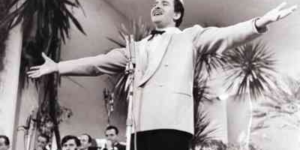
Of course, among the best-loved singers from across the border, we cannot miss Luciano Pavarotti, Mina, Al Bano, Toto Cotugno, Lucio Dalla, Paolo Conte, Vasco Rossi, Zucchero, Riccardo Cocciante, Laura Pausini and, last but not least Eros Ramazzotti.
Did you know that the first Music Conservatories in the world were born in Naples?
Yes, the Neapolitan city boasted 4 music conservatories as early as the first half of the 16th century. The oldest one was Santa Maria di Loreto (1535), followed by the Conservatorio di Sant’Onofrio a Capuana (1578), Santa Maria della Pietà dei Turchini (1584) and, finally, Poveri di Gesù Cristo (1589).
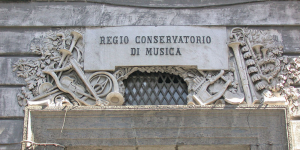
In 1797, Ferdinand IV of Bourbon ordered its closure and turned it into a military hospital. Therefore, Santa Maria di Loreto merged with Sant’Onofrio. Subsequently, the four realities joined into the current San Pietro a Majella. This music academy represents the formative and traditional core of the reputed Neapolitan School.

The prestige lies not only in the fact that Naples possesses a respectable, centuries-old musical heritage but also in why the conservatories were founded. They were structures created to “conserve” or rather protect young orphans or young people from needy families from being initiated into the profession of musician. Thanks to the craftsman Maestro Francesco, who collected numerous Neapolitan orphans, music was taught as a discipline.
E qual è la canzone più antica d’Italia?
Written by Teodoro Cottrau and initially written in Neapolitan, the enchanting combination of melody and vocals titled Santa Lucia was translated and published around 1848. It was the first Neapolitan song translated into Italian, even before the Country Unification.
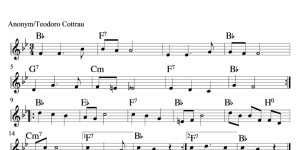
The song evokes the seaside village of Santa Lucia overlooking the Gulf of Naples. The striking picture described made the song such a resounding triumph. It overcame Italian borders to the United States, Great Britain, Scandinavian countries, Bohemia and Slovakia. The best-known version, currently widespread, is the one recorded in 1916 and performed by the brilliant Neapolitan lyric singer Enrico Caruso.
Cover image – Photo credits: Festa della Musica-Beni Culturali offcial website


